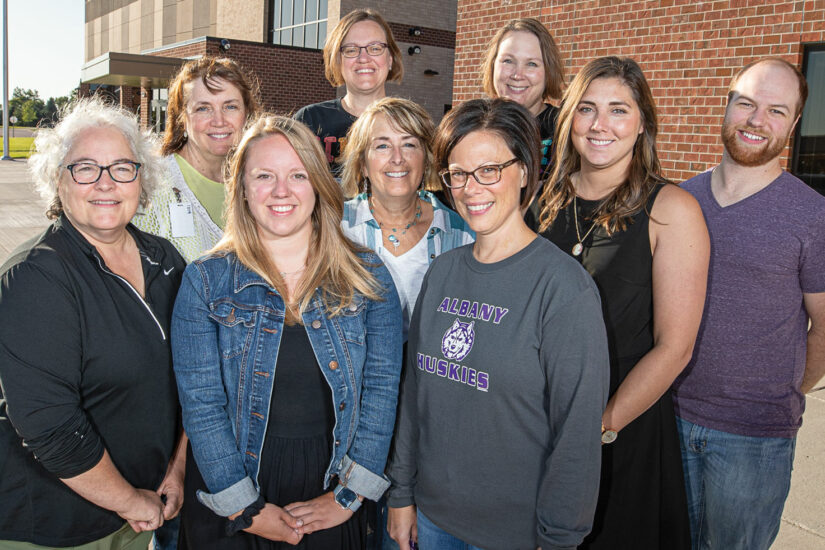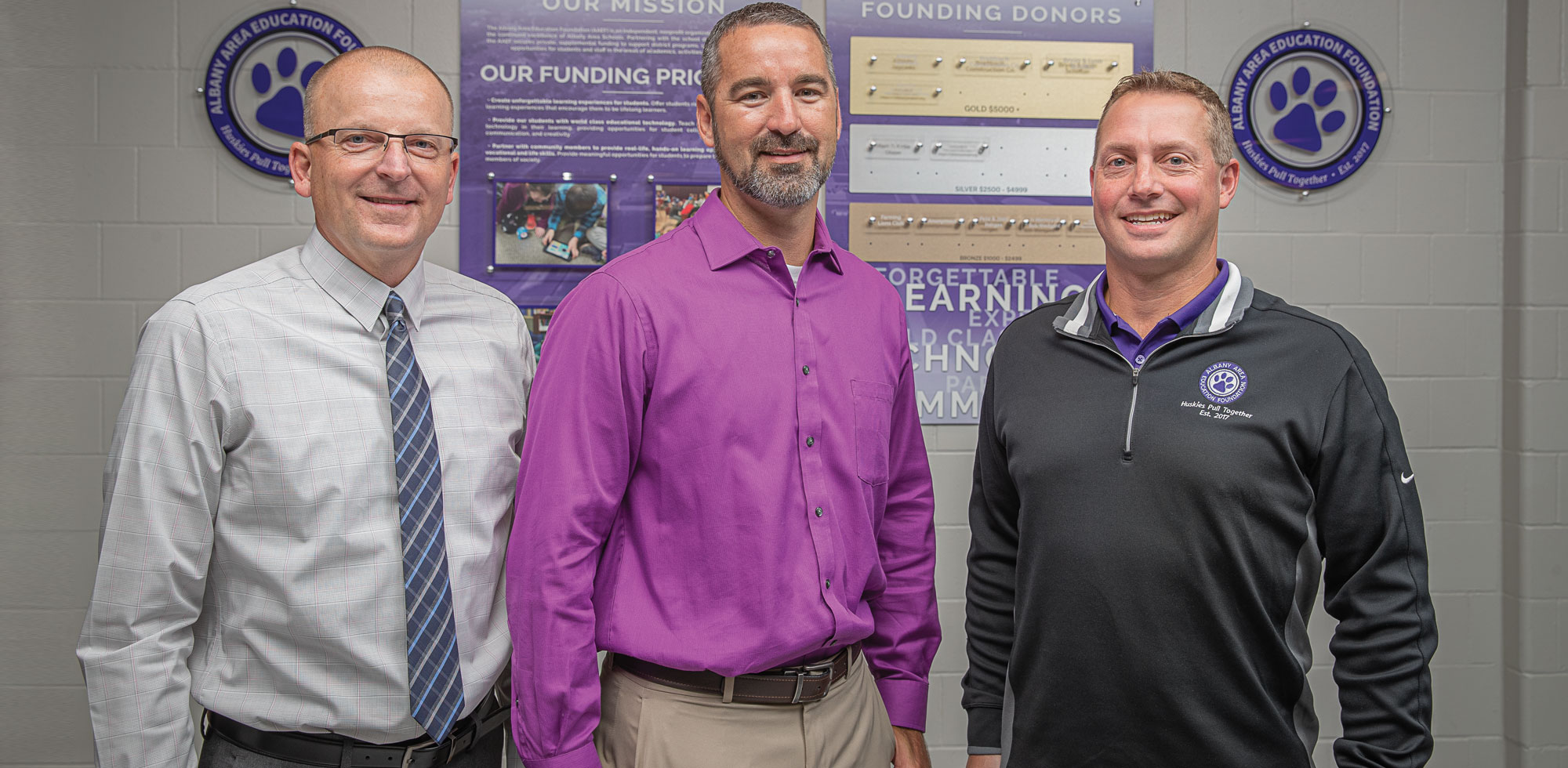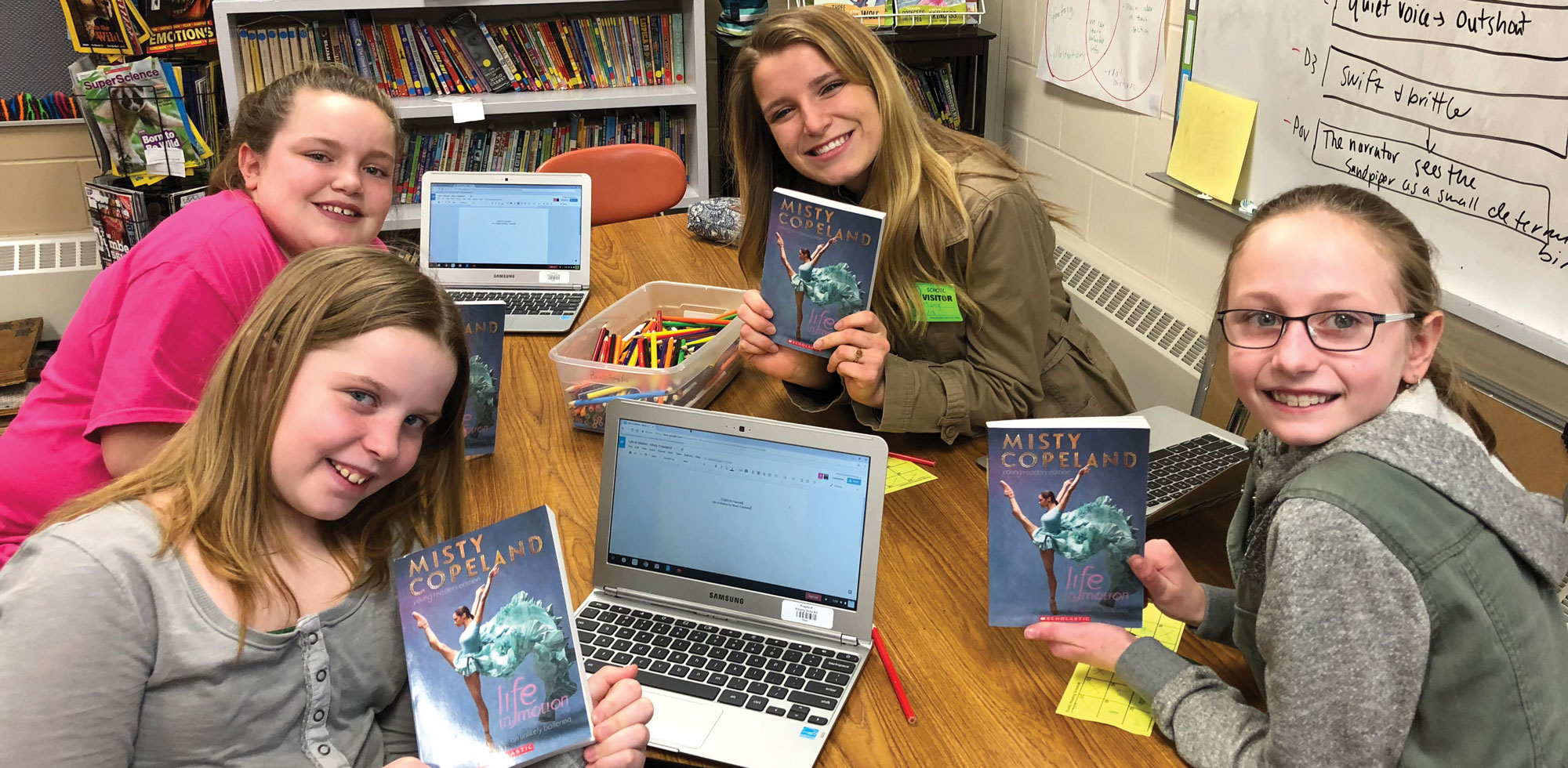
Gold Star Giving
Education foundations are providing new opportunities for public school students—and greater community-building possibilities for Central Minnesota.
By Gene Rebeck | Photography by John Linn
During the 2017-2018 school year, fourth-graders at Avon Elementary School who had trouble sustaining interest in reading received help from some remarkable new friends. Education students from nearby Saint John’s University and the College of Saint Benedict came to Avon Elementary to lead a “buddy reading program.”
Those buddies boosted the young readers’ confidence and desire to learn. “The more students are reading independently and reading books of high interest, their reading growth and achievement take off,” said Greg Johnson, superintendent for the Albany Area School District, which includes Avon Elementary. The college students serve as mentors, providing young readers with one-on-one encouragement as well as someone they can talk to about what they’re reading. “That enhances the educational experience for those kids,” Johnson added. Avon Elementary’s buddy reading program was extended for the following school year.
“Teachers work very hard but have limited resources,” said Daryn Lecy, co-chair of the Albany Area Education Foundation (AAEF). They’re very creative thinkers, but there’s no funding to support their ideas and translate them into action.
The AAEF, which provides grants to projects like Avon Elementary’s reading program, is one of several education foundations throughout Central Minnesota that are enabling schools and teachers to introduce new and expanded learning opportunities. Education funds provide community members with the opportunity to give back to their schools, said Brenda Gugglberger, a philanthropy specialist at the Initiative Foundation, which hosts the AAEF and nine other education funds.
In addition to managing each fund’s contributions and financial paperwork, the Initiative Foundation provides training and technical support to the funds’ advisory boards in areas that include governance, marketing, fundraising and grant-making. The Initiative Foundation assistance allows board members to focus less on back-office management and more on choosing projects that support their missions.
The Initiative Foundation views education funds as a fundamental source of municipal strengthening—as a tool for workforce development. “Education foundations can be a powerful way to bring communities together,” said Gugglberger. “When people come together for a common cause, everyone wins. Children are the future of our communities, so education foundations are building on that future while supporting our youth.”
 COMMON CAUSE: AAEF board members (from left to right) Greg Johnson, Bob Gerads and Daryn Lecy.
COMMON CAUSE: AAEF board members (from left to right) Greg Johnson, Bob Gerads and Daryn Lecy.
Braham and the Next Generation
For Braham native Tim Nelson, helping to start an education foundation has been a way to give back.
“I owe everything I have to the fact that I grew up in a community where people supported kids—where people made generous contributions of time and energy to create opportunities for kids to achieve everything that they’re capable of,” said Nelson, now chief deputy attorney for Isanti County. Nelson also served on the advisory council for the Initiative Foundation’s Emerging Leaders program. “When kids succeed, a lot of times we’re able to benefit from the gifts they’re able to bring out into the world. That was a big part of the motivation for me.”
Braham, like many smaller towns, has successful alumni who don’t always maintain a hometown connection. The idea for an education foundation grew in part as a way for the school district to renew and rekindle its alumni relationships.
Another inspiration for the foundation came from Ken Gagner, who arrived in Braham in 2015 to become superintendent of Independent School District 314. As a newcomer, Gagner noticed that several different groups were raising money for particular activities, such as sports teams and fields trips. The movers and shakers of these groups often disengaged once their kids graduated.
What was needed, he believed, was a single funding source: “We all want our kids to have better opportunities, better experiences,” he said. “What if we came together and formed something that was long-term, and sustainable?’”
Gagner knew about education foundations in other districts, and he found an enthusiastic supporter in Nelson. They started by taking a survey of the community to see what kind of foundation people might want to support—and what ideas they might want to endorse. They received more than 120 survey responses, which gave them confidence that their idea had merit.
The community has responded with remarkable generosity. Though just two years old, the Braham Area Education Foundation now has an endowment of more than $150,000. And that’s not due to any super donors—the largest single donation has been $5,000. “It’s been a lot of people stepping up to the plate and saying, ‘We want to be part of this,’” said Gagner.
A large part of the appeal is the sustainability of the foundation model, Gagner said. Parents and students know what it’s like to sell frozen pizzas and chocolate bars to raise funds. “That money comes in, it’s spent, and it’s gone,” he said. “And the next year, you’re selling the pizzas and chocolate bars again.” The Braham Area Education Foundation seeks to support educational opportunities and programs that aren’t already in the school budget. Notable examples of the projects that the foundation supported in its first round of grants in 2018:
- A small circuit board that can be programmed by students and introduces them to foundational concepts in computer science. • Individualized, online music lessons provided by faculty from the Minneapolis-based McPhail College of Music. (As a small district, ISD 314 has just one band instructor.)
- iPads and iPad-based tools that allow early childhood education instructors to better track kids struggling to develop language skills, and then communicate their progress to parents.
- A two-week summer theater camp for students from third through seventh grade. The education foundation’s grants kept the fees down to $25 per student, which allowed for greater and broader participation.
Each funded initiative was proposed by a teacher within the district, Nelson said. And that’s the idea: to make more teachers’ dreams for their students come true.

Excitement in Albany
Like Braham’s foundation, the AAEF has been embraced by local residents. “We have an extremely supportive community within our school district,” Albany Area schools superintendent Johnson said. In 2015, after a successful building referendum, Johnson recruited some of the same families and community members who were active in that campaign to help get the education foundation off and running.
Now just a little more than two years old, AAEF has built an endowment of more than $70,000 and has conducted two rounds of grants. Two reasons for its fast growth are the foundation’s co-chairs, Daryn Lecy and Bob Gerads, who brought financial expertise to their roles. (Gerads is chief deposit officer for St. Cloud-based Falcon National Bank; Lecy is vice president of operations for Oakmont Capital Services, a financing services company.) Both have three children in the district; Gerads and his wife also are district alumni.
Together with their foundation board colleagues, Lecy and Gerads have raised funds through a number of initiatives. The biggest is an annual “date night” gala that includes dinner, live music and raffles. “The generosity of the community has made the work of our board much easier,” Gerads said. “We haven’t needed to get super-creative. We’ve had a lot of input, and we’ve had a lot of good support.”
AAEF, in turn, has been supporting new student learning opportunities as well as teacher creativity. In 2019, the foundation awarded five $1,000 grants. One grant provided Avon Elementary students the opportunity to program robotic devices. Other grants were awarded for music and outdoor library programs, one of which was also funded by the Albany Jaycees.
One of the ways AAEF grants have made an impact is the way they’re awarded. Foundation board members surprise teachers by presenting the checks to them while school is in session. “They’re pretty excited when they find out they’ve earned that grant,” said Johnson.
Getting Started in Becker
Launched in March 2018, the Becker Education Foundation is one of the region’s newest education funds. A couple of years back, Nathan Ernst (Becker High School class of 2012) contacted Nick Crowley (a fellow soccer team member who graduated in 2009) about organizing a Becker school-district alumni network. Shortly thereafter, Ernst got wind of the educational foundation idea, an idea that also appealed to Crowley.
Crowley, who now serves as assistant director of the Benedictine Volunteer Corps at Saint John’s Abbey, and Ernst, who teaches 7th and 8th grade in Crosby-Ironton, no longer live in Becker. That makes it challenging to meet and organize. That they are younger and not experienced fundraisers means they don’t have the professional chops to be able to determine what will or won’t appeal to potential donors. So they’ve relied on the guidance of Alex Jurek, their former soccer coach and a technical education teacher at Becker High School.
“It’s nice to have these driven young adults looking for a way to help fund things like classrooms, provide help for teachers—that’s what we definitely need in this town,” Jurek said. While Ernst and Crowley do the lion’s share of the work, they rely on Jurek for advice about anything from whom to contact and what types of programs they should support.
As of early August, the Becker Education Foundation had a little over $1,200 in its coffers, most of which was raised at a foundation-sponsored gala this past spring. This fall, Ernst and Crowley are launching a campaign called the Power of 100, based on an idea suggested by the Initiative Foundation. The idea is to get 100 people to donate $100 each. They also plan to reach out to area businesses for larger donations.
The Becker Education Foundation is still getting started. But if the success of other education funds in Central Minnesota is any sign, it won’t take long for Ernst, Crowley and the community that nurtured them to help open up new worlds of learning to a new generation.
Funding Features
The Initiative Foundation hosts more than 130 Partner Funds. Contact Amy Gray to learn more about starting an education foundation.